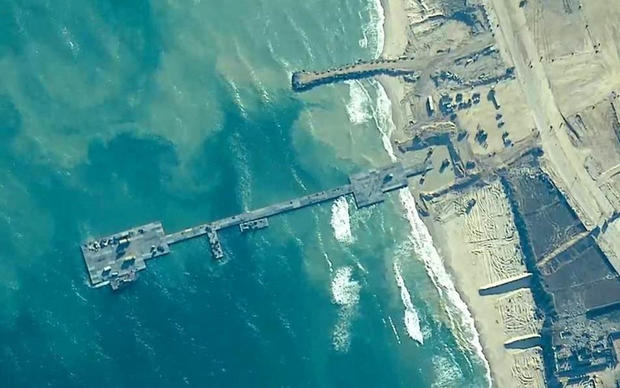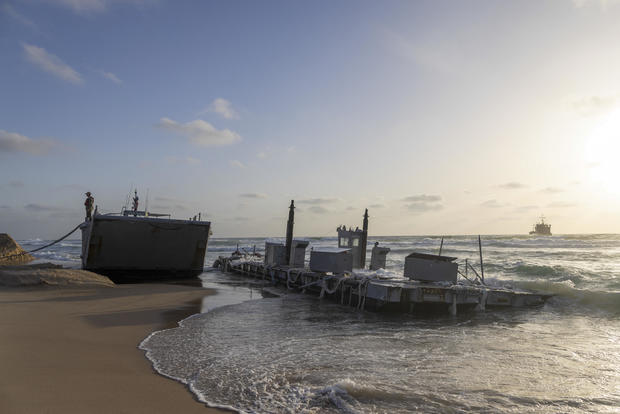
A first up-close look at the U.S. military’s Gaza pier project, which has struggled to get aid to Palestinians
Off the coast of Gaza — CBS News was among the first media outlets invited by the U.S. Army to travel across the eastern Mediterranean Sea on a military vessel to see the pier constructed by American forces off the coast of the war-torn Gaza Strip. The Tuesday visit came just as operations resumed on the $230 million floating pier, after it was knocked out of commission by rough seas.
From the floating platform, the CBS News team could see entire neighborhoods in ruins, but the destruction inside the small, densely populated Palestinian territory was completely off limits to the journalists.
President Biden announced the pier project as a way to get more humanitarian aid to hundreds of thousands of Palestinians in desperate need, as Israel’s devastating war against the enclave’s long-time Hamas rulers grinds on into its 10th month.
U.S. Central Command handout via Reuters
The U.S. troops who built and operate the pier don’t set foot inside Gaza either. The pier, which clangs and shakes even in calm seas, has been plagued by problems — so many, in fact, that it’s only been fully operational for around 16 days since it first opened to aid shipments. At one point a section of it was beached by bad weather.
rescued four hostages in an operation inside Gaza earlier this month. An Israeli military helicopter was seen taking off from the beach in front of the pier during the operation, which health officials in the area say killed more than 270 Palestinians.
The U.N.’s World Food Program suspended operations involving the pier out of concern the project had been compromised.
“This is a humanitarian pier,” Colonel Samuel Miller, commander of the U.S. Army’s 7th Transportation Brigade, told CBS News when asked whether both the security and the integrity of the pier remained intact. “It was not part of any operation. It’s focused on humanitarian assistance, and that’s my mission, and I’m going to continue to march through that, no matter what is in front of us obstacle-wise.”
OREN ZIV/AFP/Getty
Trucks carrying pallets of desperately needed food aid are slowly making it across the pier and into the besieged Palestinian territory, but since the project became operational two months ago, only about 400 aid trucks have rolled off the structure. That’s nowhere near enough to even have a significant impact, given the scale of need among Gaza’s roughly 2.3 million people.
Before the Oct. 7 attacks, more than 500 truckloads of aid would routinely enter Gaza in a single day. Since then, the United Nations says more than half of the territory’s population have been displaced from their homes, many of them multiple times, by the fighting.
Virtually all of Gaza’s infrastructure, from hospitals to bakeries and schools, has been severely impacted, if not destroyed, and particularly in the northern part of the territory, furthest from the aid entry points, there are desperate food shortages.
Netanyahu says heavy fighting in Rafah nears end, but fears of war with Hezbollah rise
02:09
The U.N.’s Food and Agriculture Organization issued a statement Wednesday warning there was a “high risk of famine across the whole Gaza Strip” if the war continues and aid deliveries don’t ramp up.
“All I know is my objective is to get as many supplies as I can into Gaza for the people of Gaza,” Col. Miller told CBS News.
Since Israel launched its war in response to Hamas’ Oct. 7 terrorist attack, which saw the militants kill some 1,200 people and kidnap more than 240 others, Israel and Egypt, which control the only functional border crossings, have blocked international journalists from entering the Palestinian territory.
Gaza’s Hamas-run Ministry of Health says the war has killed more than 37,400 Palestinians, many of them women and children.
More
More
Source: cbsnews.com

